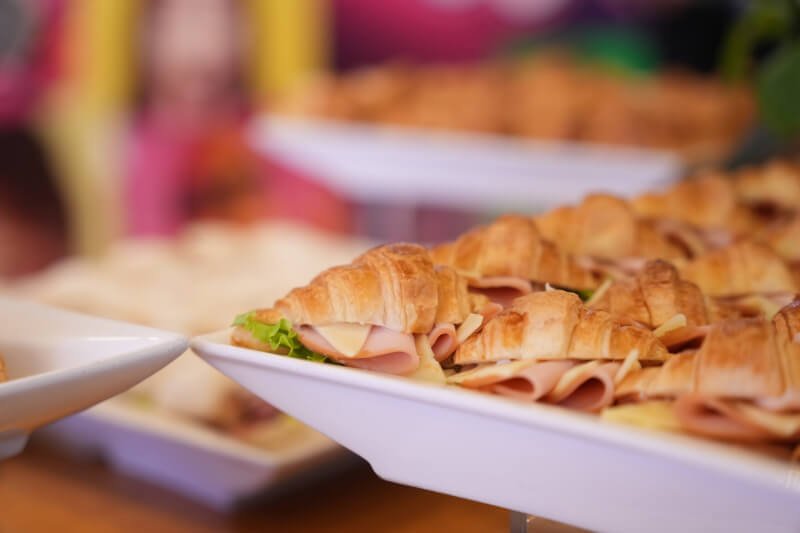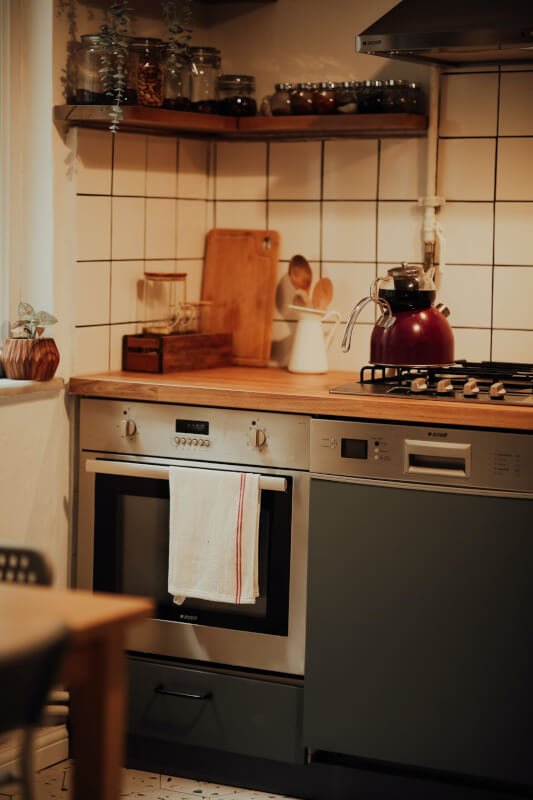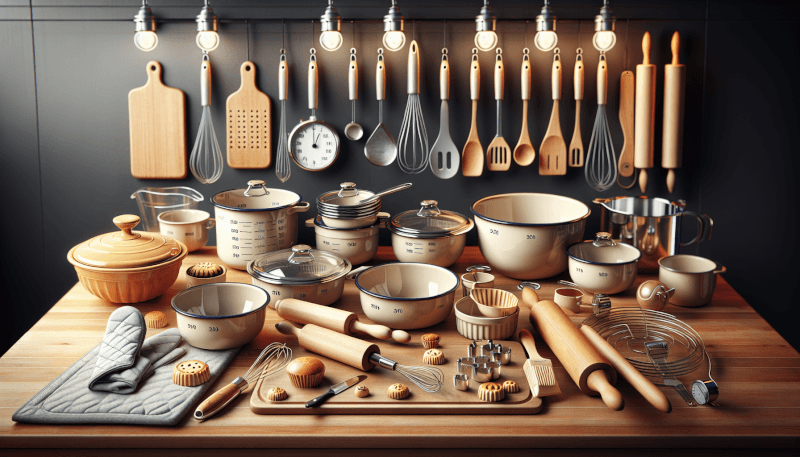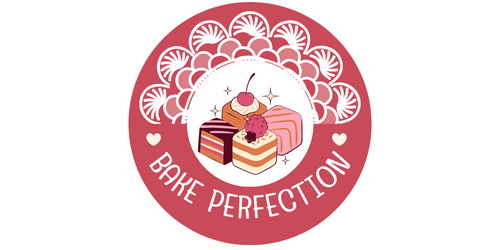If you’re just starting out on your baking journey, you may be wondering what essential tools you should have in your kitchen. Well, look no further! In this article, we’ll be sharing the top 10 must-have home baking tools for beginners. From measuring cups to mixing bowls, we’ve got you covered. So, grab your apron and get ready to bake up a storm with these essential tools by your side. Let’s dive in and discover the best tools to elevate your baking game to a whole new level!

Oven
When it comes to baking, the oven is an essential tool in every baker’s kitchen. There are different types of ovens available, but let’s start with two popular ones: the convection oven and the conventional oven.
Convection Oven
A convection oven is designed to distribute heat evenly throughout its interior. It uses a fan and exhaust system to circulate hot air, resulting in faster and more consistent baking. This type of oven is perfect for baking delicate pastries, like soufflés or macarons, as well as roasting meats to perfection. With a convection oven, you can achieve that beautiful golden brown crust on your baked goods in a shorter amount of time.
Conventional Oven
On the other hand, a conventional oven is what most people are familiar with. It uses heating elements located at the top and bottom of the oven, and sometimes also on the sides. While it may take a bit longer to preheat compared to a convection oven, it still does a fantastic job at baking all sorts of delicious treats. From cakes and cookies to casseroles and bread, a conventional oven is a versatile and reliable option for any home baker.
Toaster Oven
If you’re tight on space or don’t bake in large quantities, a toaster oven could be a great alternative. It’s much smaller than a conventional oven and is typically used for toasting bread or heating up leftovers. However, don’t underestimate its baking capabilities. A toaster oven can still bake small batches of cookies or even a mini cake to satisfy your sweet tooth. It’s a convenient option for those who want to experiment with baking without investing in a full-size oven.
Baking Pans
Once you have your oven sorted, it’s time to turn our attention to baking pans. These are essential tools that determine the shape and size of your baked goods. Here are some popular types of baking pans:
Cake Pans
Cake pans come in various sizes and shapes, such as round, square, and rectangular. They are typically used for baking cakes, but they can also be used for making brownies, bars, or even lasagnas. When choosing a cake pan, opt for ones with non-stick coating to ensure easy release of your baked creations.
Muffin Pans
Muffin pans are a must-have for any baker who loves creating cupcakes or muffins. They come in different sizes, including standard, mini, and jumbo. Having a non-stick muffin pan will make it easier to remove your baked treats without any sticking or crumbling.
Cookie Sheets
Cookie sheets, also known as baking sheets, are perfect for making cookies, biscuits, or even roasting vegetables. They typically have a flat, rimmed surface which allows air to circulate around the food, promoting even baking. Look for ones made of heavy-gauge aluminum or stainless steel for durability and even heat distribution.
Pie Pans
If you’re a fan of homemade pies, investing in pie pans is a must. These pans are designed to hold the pie crust and filling while it bakes. They come in various materials, such as glass, ceramic, or metal. Glass pie pans tend to produce a crisp and flaky crust, while metal pans result in a golden brown crust. Choose the one that suits your baking preferences.
Loaf Pans
Loaf pans are essential for baking bread, cakes, and meatloaf. They typically come in a rectangular shape with straight sides and a flat bottom. Non-stick loaf pans are highly recommended to ensure easy removal of your baked goods without any breakage or sticking.

Mixing Bowls
Mixing bowls are a staple in any kitchen, providing a versatile and convenient way to mix ingredients together. Here are some common types of mixing bowls:
Glass Bowls
Glass bowls are a popular choice among bakers because they are sturdy, versatile, and resistant to staining. They are great for mixing batters, whisking eggs, or even marinating meats. Glass bowls also retain heat, making them suitable for tasks that require temperature control, such as melting chocolate or proofing yeast.
Stainless Steel Bowls
Stainless steel bowls are known for their durability and non-reactive properties. They are excellent for mixing acidic ingredients, like lemon juice or tomatoes, without imparting any metallic taste. Stainless steel bowls also stay cool, making them perfect for tasks that require chilling ingredients, such as whipping cream or making meringue.
Plastic Bowls
Plastic bowls are lightweight and easy to handle, making them ideal for everyday baking needs. They come in various sizes and colors, allowing you to choose ones that suit your style and preferences. Plastic bowls are also microwave-safe, making them convenient for tasks that require heating or melting ingredients.
Measuring Tools
Accurate measurements are crucial in baking to ensure consistent results and the perfect balance of flavors. Here are some essential measuring tools every beginner baker should have:
Measuring Cups
Measuring cups are used to measure liquid ingredients, such as milk or oil, as well as dry ingredients like flour or sugar. They typically come in sets, ranging from 1/4 cup to 1 cup capacity. Look for measuring cups with clear markings and easy-to-read measurements.
Measuring Spoons
Measuring spoons are used for smaller measurements, such as teaspoons or tablespoons. They come in sets, allowing you to measure precise amounts of spices, baking powder, or vanilla extract. Look for measuring spoons with long handles for easy scooping and leveling.
Kitchen Scale
While measuring cups and spoons are great for most recipes, a kitchen scale can take your baking to the next level of accuracy. A kitchen scale allows you to measure ingredients by weight, which is especially helpful when it comes to flour or butter. It ensures consistent results every time and is a valuable tool for those who love to follow recipes precisely.

Whisk
A whisk is a versatile tool that helps incorporate air into your batters, emulsify sauces, or whip cream. There are different types of whisks available, each serving a specific purpose. Let’s take a look at two popular ones:
Balloon Whisk
A balloon whisk is the most common type of whisk, featuring a bulbous, rounded shape with many wires. It’s perfect for whisking eggs, blending batters, or whipping cream. The wires of a balloon whisk ensure thorough mixing and aeration, resulting in light and fluffy textures.
French Whisk
A French whisk, also known as a flat whisk, has a unique shape with a long, narrow profile. It’s designed to be effective in pots and pans with straight sides, making it ideal for making sauces, gravies, or custards. The wide, flat wires of a French whisk are perfect for achieving a smooth and consistent texture without creating any lumps.
Rubber Spatula
A rubber spatula is a versatile tool that helps you scrape every last bit of batter from the bowl, fold delicate ingredients together, or spread frosting smoothly. There are different types of rubber spatulas available, including straight and offset spatulas.
Straight Spatula
A straight spatula, also known as a straight-edged spatula, is a go-to tool for baking. It has a flat, straight blade that is perfect for spreading, smoothing, or leveling batter in baking pans. A straight spatula can also be used for lifting delicate cookies off baking sheets or loosening cakes from their pans.
Offset Spatula
An offset spatula, also known as an angled spatula, has a blade that is set at an angle to the handle. This design allows you to ice cakes or spread frosting with precision, easily reaching into corners and creating smooth, even layers. An offset spatula is also handy for lifting fragile cookies or transferring delicate pastries to serving plates.

Rolling Pin
A rolling pin is an essential tool in any baker’s arsenal, used for rolling out dough to the desired thickness. There are different types of rolling pins available, but let’s focus on two popular options:
Wooden Rolling Pin
A wooden rolling pin is a classic choice that many bakers prefer. It’s made of hardwood, providing a sturdy and comfortable grip. Wooden rolling pins are versatile and suitable for all types of dough, from pie crusts to cookie dough. They are also less likely to stick to the dough compared to other materials.
Marble Rolling Pin
A marble rolling pin is an elegant and functional tool that can help keep your dough cool during the rolling process. The natural coolness of marble helps prevent the dough from becoming too warm and sticky, making it easier to work with. Marble rolling pins are great for delicate pastry dough or laminated dough, like puff pastry or croissant dough.
Pastry Brush
A pastry brush is a versatile tool that allows you to apply glazes, butter, or egg washes to your baked goods. There are different types of pastry brushes, but let’s explore two popular options:
Silicone Pastry Brush
A silicone pastry brush is a modern alternative to traditional bristle brushes. It’s heat-resistant and easy to clean, making it a hygienic choice for many bakers. Silicone brushes are great for applying glazes, egg washes, or sauces without leaving behind bristles.
Bristle Pastry Brush
A bristle pastry brush, often made with natural or synthetic bristles, has been a staple in baking for years. It’s perfect for brushing melted butter over bread, spreading egg washes on pastry dough, or applying oil to baking pans. Bristle brushes allow for even distribution of liquids and are available in various sizes to suit different baking needs.

Cooling Racks
After you take your freshly baked goods out of the oven, it’s essential to let them cool properly to avoid sogginess. Cooling racks are designed to elevate your baked goods, allowing air to circulate underneath and around them. Here are two common types of cooling racks:
Wire Cooling Racks
Wire cooling racks, often made of stainless steel, are the most popular choice among bakers. They have a grid-like structure that provides excellent airflow, helping your baked goods cool down faster. Wire cooling racks are also durable and easy to clean, making them a practical addition to any baker’s kitchen.
Stackable Cooling Racks
If you’re short on counter space or like to bake in large batches, stackable cooling racks are a great option. These racks can be stacked on top of each other, allowing you to cool multiple batches of cookies or cupcakes without taking up too much space. They are also versatile and can be used individually when needed.
Piping Bags and Tips
If you love decorating cakes, cupcakes, or pastries, piping bags and tips are essential tools to have. They allow you to create beautiful designs and add intricate details to your baked creations. Here are two types of piping bags and tips that you should consider:
Disposable Piping Bags
Disposable piping bags are a convenient option for those who prefer easy cleanup. These bags are made of lightweight, flexible plastic and can be easily disposed of after use. They work well with most piping tips and are great for beginners or occasional bakers.
Reusable Piping Bags
For those who are more environmentally conscious or frequently bake, reusable piping bags are a sustainable alternative. These bags are made of high-quality materials, such as silicone or cloth, and can be easily washed and reused. They provide a more sturdy and durable option for piping, giving you better control over your decorative designs.
Piping Tips
Piping tips, also known as pastry tips or decorating tips, are attachments that fit onto the end of your piping bag. They come in a variety of shapes and sizes, allowing you to create different patterns, borders, or flowers. Popular piping tip designs include star tips, round tips, and leaf tips. Experimenting with different piping tips can elevate your baking creations and add that extra touch of elegance.
In conclusion, these top 10 must-have home baking tools for beginners will set you up for success in your baking adventures. From ovens and baking pans to mixing bowls and measuring tools, having the right equipment can make a significant difference in your baking results. Remember to choose tools that suit your baking preferences and take your skills to the next level. Happy baking!


